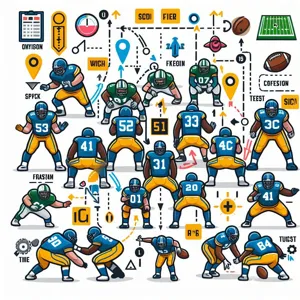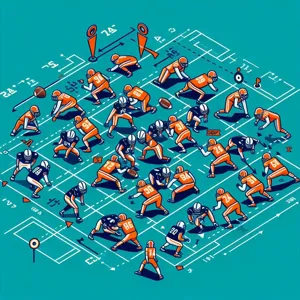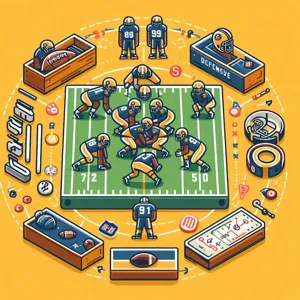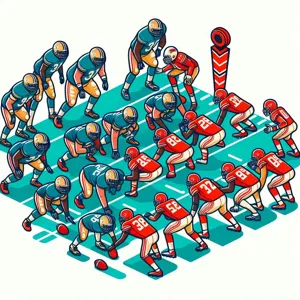Soccer, often dubbed “the beautiful game,” is as much about strategy and teamwork as it is about skill and athleticism.
At the heart of every successful match lies the intricate dance of formations, each crafted to exploit the strengths of players while countering the tactics of opponents. Understanding these formations is crucial for players, coaches, and fans alike, as they dictate everything from defensive solidity to attacking flair. In this comprehensive guide, we will unpack the most prevalent soccer formations—from the classic 4-4-2 to the modern 4-3-3—and delve into the strategies that underpin them. Whether you’re a seasoned player looking to refine your tactical knowledge or a new fan eager to grasp the nuances of the game, this exploration of soccer formations will equip you with the insights needed to appreciate the tactical depth that makes soccer one of the most beloved sports in the world. Join us as we break down these formations and discover how they shape the flow of the game!
1. Introduction to Soccer Formations
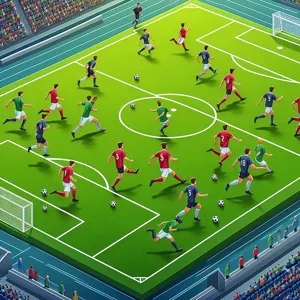
Soccer formations are the backbone of any team’s strategy on the pitch, serving as the blueprint that guides players in their positioning, movement, and tactical responsibilities. At its core, a formation is a way of organizing a team’s players on the field, typically described using a series of numbers that represent the distribution of defenders, midfielders, and attackers. For instance, a classic 4-4-2 formation denotes four defenders, four midfielders, and two forwards, while a more aggressive 3-5-2 formation emphasizes a stronger midfield presence with three defenders and two strikers.
Understanding soccer formations goes beyond mere numerical representation; it delves into the philosophy of how a team wants to play. Some formations prioritize defensive solidity and counter-attacking prowess, while others are designed to dominate possession and create scoring opportunities through intricate passing and movement. Coaches often choose formations based on their players’ strengths, the opponent’s style of play, and the game situation, making formations dynamic and adaptable.
As we unpack the various formations and their associated strategies, we’ll explore how different setups can influence a match’s flow and outcome. From the rigid structure of a defensive formation like the 5-3-2, which aims to thwart the opposition’s advances, to the fluidity of a 4-3-3 that encourages attacking play and width, each configuration comes with its own set of advantages and challenges. Moreover, we’ll delve into how formations evolve throughout the course of a game, with teams often shifting their setups in response to the unfolding action on the field.
Join us as we journey through the intricacies of soccer formations, illuminating how the right arrangement can lead to tactical brilliance and, ultimately, success on the pitch. Whether you’re a seasoned player, a passionate fan, or someone new to the sport, understanding these formations will deepen your appreciation for the beautiful game and the strategy that underpins it.
2. The Importance of Formations in Soccer Strategy
Soccer formations are the backbone of any team’s strategy, serving as the blueprint that dictates how players position themselves on the field and interact with one another during a match. Understanding the importance of formations is crucial not just for coaches and players, but also for fans who want to deepen their appreciation for the game.
At its core, a formation shapes the team’s overall style of play—from attacking strategies to defensive resilience. For instance, a classic 4-4-2 formation offers a balanced approach, providing stability in defense while allowing for two strikers to push forward in attack. This setup can be particularly effective when trying to maintain control of the midfield, as the four midfielders can create a solid wall against opposing attacks while also supporting forward moves.
Conversely, formations like the 3-5-2 can transform a team into a more aggressive unit, populating the midfield with five players and allowing wing-backs to exploit the flanks. This formation emphasizes width, creating opportunities for crosses and exploiting defensive weaknesses. However, it also requires discipline and stamina, as the wing-backs must track back defensively, creating a balance between attack and defense.
Moreover, the choice of formation can serve as a psychological tool, influencing not just the players’ mindset but also that of the opposing team. A team that lines up in a surprising or unconventional formation can unsettle opponents, forcing them to adapt on the fly and often leading to mistakes. The tactical flexibility offered by formations also allows teams to adjust their strategies mid-game, responding to the dynamics of the match as they unfold.
In summary, formations are much more than mere numbers on a tactical board; they represent a team’s identity, philosophy, and approach to the beautiful game. Whether a team opts for a defensive setup to preserve a lead or a bold attacking formation to chase victory, understanding the implications behind these choices is essential for grasping the intricacies of soccer strategy.
3. Overview of Common Soccer Formations

Understanding soccer formations is crucial for grasping the strategies teams employ on the field. Each formation serves a unique purpose and can dramatically alter a team’s approach to both defense and attack. Here’s an overview of some of the most common formations you’ll see in the beautiful game:
1. **4-4-2 Formation**: This classic formation features four defenders, four midfielders, and two forwards. It strikes a balance between defense and offense, making it versatile for various playing styles. Teams utilizing the 4-4-2 often prioritize wing play, allowing wingers to create width and provide crosses for the strikers. It’s a formation that’s easy to understand, making it a popular choice for many coaches.
2. **4-3-3 Formation**: Favored by teams that emphasize attacking football, the 4-3-3 formation comprises four defenders, three midfielders, and three forwards. This setup allows for dynamic attacking play, with the front three creating pressure on the opposition’s defense. The midfield trio can be configured in various ways, such as holding, box-to-box, or creative playmakers, providing tactical flexibility.
3. **3-5-2 Formation**: Known for its strength in midfield, the 3-5-2 features three central defenders, five midfielders, and two forwards. This formation is particularly effective in dominating possession and controlling the center of the pitch. The wing-backs play a crucial role, providing width and support in both defensive and attacking phases. This can create overloads in the midfield while still allowing for swift counter-attacks.
4. **5-3-2 Formation**: This formation is primarily defensive, featuring five defenders, three midfielders, and two forwards. Often employed by teams looking to secure a solid defense while countering effectively, the 5-3-2 allows for compactness at the back and quick transitions. The wing-backs can also push forward when in possession, transforming the formation into a more aggressive setup.
5. **4-2-3-1 Formation**: A favorite among modern teams, the 4-2-3-1 consists of four defenders, two holding midfielders, three attacking midfielders, and one striker. This formation allows for a strong defensive structure while providing ample support for the attack. The two holding midfielders offer protection for the backline, allowing the three attacking midfielders to express themselves creatively and link up with the lone striker.
Each of these formations comes with its own set of strategies and nuances, tailored to the strengths of the players and the overall game plan of the team. As you delve deeper into the world of soccer, understanding these formations will enhance your appreciation for the tactical battles that unfold on the pitch.
– 4-4-2 Formation
The 4-4-2 formation has long been a cornerstone of soccer tactics, beloved by coaches and players alike for its balance and versatility. This classic setup features four defenders, four midfielders, and two forwards, creating a well-structured team that can adapt easily to various phases of play. At first glance, the simplicity of the 4-4-2 might seem underwhelming, but its effectiveness lies in its flexibility and ability to facilitate both defensive solidity and attacking opportunities.
In defense, the back four forms a compact line that can withstand opposing attacks while allowing for quick transitions into counterattacks. The two central defenders provide the backbone, leveraging their physicality and aerial prowess to thwart opposition strikers. Flanking them are two full-backs who not only protect the wings but also have the freedom to push forward, providing width and support to the midfield.
The midfield quartet is where the magic happens. Typically, the midfielders are arranged in two central and two wide positions. The central midfielders are tasked with controlling the tempo, distributing the ball, and breaking up opposition plays, while the wingers stretch the pitch, providing essential width and crossing opportunities. This dynamic setup allows for quick ball movement and the ability to exploit gaps in the opposition’s defense, making it easier for the two forwards to find goal-scoring opportunities.
When it comes to attacking, the 4-4-2 formation thrives on partnerships. The two forwards often develop a symbiotic relationship—one might play as a target man, holding up the ball and bringing others into play, while the other uses speed and agility to exploit spaces behind the defense. This combination can create a formidable attacking threat, especially when supported by overlapping runs from the wingers.
Historically, the 4-4-2 has been employed successfully by many top clubs and national teams, from the dominant Manchester United under Sir Alex Ferguson to the tactical brilliance of Italy’s 2006 World Cup-winning side. Its enduring popularity is a testament to its effectiveness, allowing teams to maintain a solid defensive structure while still being potent in attack. As soccer continues to evolve with more complex formations and strategies, the 4-4-2 remains a reliable choice for those looking to balance stability with offensive flair.
– 4-3-3 Formation
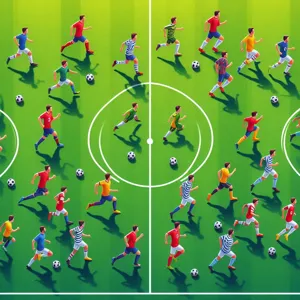
The 4-3-3 formation is one of the most dynamic and popular setups in modern soccer, celebrated for its balance between defense and attack. Comprised of four defenders, three midfielders, and three forwards, this formation creates ample opportunities for fluid play and versatility on the field.
At the back, the four defenders typically include two center-backs and two full-backs. The center-backs provide a solid foundation, working together to thwart opposing attacks, while the full-backs have the freedom to join the offensive play, stretching the opponent’s defense and providing width. This dual role not only fortifies the back line but also allows for overlapping runs that can exploit spaces left by defenders drawn out by the wingers.
In midfield, the three players are often arranged to include a holding midfielder flanked by two more attacking-minded players. The holding midfielder acts as a shield for the defense, breaking up opposition plays and facilitating transitions from defense to attack. Meanwhile, the two more advanced midfielders support the strikers and help in creating scoring opportunities, linking up play and driving forward whenever possible.
Up front, the three forwards—typically consisting of a central striker and two wingers—are vital for a team’s attacking thrust. The central striker serves as the focal point of the attack, holding up the ball and converting chances into goals. The wingers, positioned wider, use their speed and dribbling skills to stretch the defense, cutting inside to take shots or delivering crosses for the striker to capitalize on.
Overall, the 4-3-3 formation emphasizes an attacking style of play while maintaining defensive solidity. It encourages teamwork and movement, allowing teams to adapt to various situations on the pitch. Coaches favor this formation not only for its adaptability but also for its potential to dominate possession and create scoring chances, making it a powerful strategy in the game of soccer.
– 3-5-2 Formation
The 3-5-2 formation, a tactical setup that has gained popularity in modern soccer, is characterized by its unique blend of defensive solidity and attacking flair. With three central defenders anchoring the backline, this formation offers a robust defensive structure, allowing teams to absorb pressure while maintaining a strong presence in the midfield. This is crucial in a game where possession often dictates the flow of play.
At the heart of the 3-5-2 is the midfield quintet, which typically includes two central midfielders and two wing-backs that play a pivotal role. The wing-backs, often the most dynamic players on the pitch, are tasked with the dual responsibility of defending against opposition wingers and providing width during attacks. Their ability to transition quickly from defensive duties to supporting the forwards makes them essential in this formation. When executed well, the wing-backs can stretch the opposition, creating space for the central midfielders to exploit.
The two strikers in a 3-5-2 formation often complement each other, with one playing a more traditional role as a target man while the other utilizes pace and movement to penetrate behind defenses. This dual threat not only puts pressure on the opposing backline but also allows for versatile attacking options, whether it be through aerial balls or quick, intricate passing sequences.
However, the effectiveness of the 3-5-2 formation relies heavily on the team’s discipline and adaptability. When defending, the wing-backs must drop back to form a five-person defensive line, ensuring that the team remains organized and compact. Conversely, during attacking phases, it requires fluid movements and quick decision-making from all players to maintain balance and prevent counter-attacks.
The 3-5-2 formation has proven beneficial for teams looking to establish control in midfield while remaining defensively sound. Its versatility allows coaches to adjust tactics based on the opponent, making it a favored choice for teams aiming to blend solidity with offensive prowess. Successfully implementing this formation can lead to a tactical edge, often catching opponents off guard with its ability to transition swiftly between defense and attack.
– 5-3-2 Formation

The 5-3-2 formation, often regarded as a robust and defensive setup, has gained popularity among teams looking to strike a balance between solidifying their backline and finding opportunities on the counterattack. In this formation, five defenders provide a formidable wall against opposition attacks, while three midfielders work tirelessly to control the game’s tempo and link play between defense and attack.
At the heart of the 5-3-2 is the defensive line, which typically consists of two center-backs flanked by two wing-backs. These wing-backs are crucial to the strategy, as they not only defend but also push forward to support the attack, often overlapping with the forwards. This dual role allows the team to transition swiftly from defense to offense, making it a dynamic choice for managers who value versatility.
The three midfielders often include a central playmaker who orchestrates the game and two box-to-box players who consistently contribute to both defensive duties and attacking runs. This midfield setup can disrupt the opposition’s rhythm while providing the necessary support for the two strikers up front.
The two forwards in the 5-3-2 formation can be one of the most exciting aspects of this strategy. Often a blend of a physical target man and a quicker, more agile partner, they can create a variety of goal-scoring opportunities. This duo can exploit the space created by the wing-backs and midfielders, using their combined skills to stretch defenses and capitalize on any lapses.
However, the 5-3-2 is not without its challenges. It requires disciplined players who can execute their roles effectively, especially in terms of maintaining shape and balance. If the wing-backs push too far forward without adequate cover, it can leave the defense vulnerable to quick counterattacks. Furthermore, this formation can sometimes lead to a lack of width in attack if the wing-backs are not utilized properly, making it essential for teams to have a clear understanding of their tactical approach.
In summary, the 5-3-2 formation is a versatile and strategic choice that offers teams the opportunity to defend resolutely while still posing a threat in attack. With the right personnel and execution, it can be a highly effective way to dominate matches and secure valuable points in competitive play.
4. Analyzing the 4-4-2 Formation: Strengths and Weaknesses
The 4-4-2 formation is one of the most iconic and widely recognized setups in soccer, often hailed for its balance and simplicity. Comprising four defenders, four midfielders, and two forwards, it offers a solid structure that can be adapted to various playing styles. But as with any formation, it comes with its own set of strengths and weaknesses.
**Strengths:**
One of the primary advantages of the 4-4-2 is its defensive solidity. With four dedicated defenders, teams can effectively establish a strong backline, making it difficult for opposing forwards to penetrate. The double pivot in the midfield allows for robust ball recovery and transition play, providing a shield in front of the defense while also supporting attacking movements. This structure also encourages width; the two wingers can stretch the play, providing crucial crossing opportunities for the strikers and creating space in the center of the field.
Additionally, the 4-4-2 formation is versatile in its approach to both offense and defense. When defending, the midfielders can drop back to form a compact shape, while in attack, the wingers can push forward to create overloads on the flanks. This adaptability makes it a favorite among coaches who appreciate a balanced approach to the game.
**Weaknesses:**
However, the 4-4-2 is not without its drawbacks. One significant weakness lies in its vulnerability to teams that employ a three-man midfield. When faced with a formation that outnumbers the midfield, the two central midfielders may struggle to maintain possession and control of the game. This can lead to gaps opening up in the midfield, allowing the opposition to dominate the center of the pitch and dictate the flow of play.
Moreover, the reliance on wingers means that if they are effectively marked or fail to track back, the 4-4-2 can become susceptible to counterattacks. Without adequate support from the midfielders, the outside backs may also find themselves exposed, creating additional pressure on the defense.
In conclusion, while the 4-4-2 formation boasts a balanced approach that has stood the test of time, teams must be aware of its limitations. Understanding both its strengths and weaknesses is crucial for coaches and players alike to maximize its potential on the pitch, ensuring they can adapt their strategies in response to their opponents.
5. Exploring the 4-3-3 Formation: Offensive and Defensive Strategies
The 4-3-3 formation is one of the most popular and versatile setups in modern soccer, celebrated for its balance between offensive flair and defensive solidity. This formation employs four defenders, three midfielders, and three forwards, allowing teams to maintain a strong presence across the pitch while facilitating dynamic gameplay.
### Offensive Strategies
When it comes to attack, the 4-3-3 formation shines with its emphasis on width and pace. The three forwards typically consist of a central striker and two wingers, who stretch the opposing defense and create space for midfielders to push forward. The wingers often cut inside, allowing overlapping runs from the full-backs, which can confuse defenders and create goal-scoring opportunities.
In this setup, the midfielders play crucial roles. The central midfielder often acts as a playmaker, orchestrating the flow of the game, distributing the ball effectively, and linking with the forwards. This player is pivotal in both transitioning from defense to attack and in maintaining possession. The two other midfielders, often positioned on the flanks, can alternate between supporting the attack and tracking back to assist with defensive duties.
### Defensive Strategies
Defensively, the 4-3-3 formation is equally strategic. The four defenders form a solid backline, with the center-backs responsible for nullifying opposing forwards and the full-backs tasked with closing down wingers and providing cover. When defending, the team can shift into a compact shape, allowing the three midfielders to drop back and create a formidable barrier against counter-attacks.
The midfield trio can adapt their roles based on the game situation. For instance, one midfielder may drop deeper to act as a shield for the defense, while the others press high up the pitch to win back possession. This pressing strategy can force opponents into mistakes, creating quick counter-attack opportunities.
Overall, the 4-3-3 formation is celebrated for its fluidity and adaptability, enabling teams to seamlessly transition between attacking and defensive phases. Whether it’s unleashing an aggressive offensive or maintaining a disciplined defensive stance, this formation remains a go-to choice for coaches looking to maximize their team’s potential on the field.
6. Understanding the 3-5-2 Formation: Midfield Dominance
The 3-5-2 formation is a tactical approach that emphasizes midfield dominance, creating a balance between defense and attack while offering teams the flexibility to adapt during the game. At first glance, the formation might seem unconventional, with its three central defenders forming a sturdy backbone. However, it’s in the midfield where this strategy truly shines, allowing teams to control the tempo and dictate the flow of play.
In a 3-5-2 setup, the three defenders are tasked with not only guarding against opposing attackers but also initiating offensive plays. This formation typically features two wing-backs who are crucial to its success. These players must possess exceptional stamina and versatility, as they are responsible for both defending against wide attacks and providing width in the attack. This dual responsibility can stretch the opposing defense, creating spaces for midfielders and forwards to exploit.
The heart of the formation lies in its five midfielders, which can be configured in various ways, depending on the team’s style of play. A common approach is to deploy one or two holding midfielders whose primary role is to break up opposition plays and maintain possession. Flanked by more attacking midfielders, this setup allows for quick transitions from defense to attack. The attacking midfielders can frequently interchange positions, keeping the opposition guessing and creating opportunities for the strikers.
Ultimately, the 3-5-2 formation is about creating a numerical advantage in the midfield, enabling teams to control possession, dominate the center of the pitch, and launch effective counter-attacks. While it requires disciplined players who can adapt to the fluid nature of the game, when executed correctly, it can lead to a potent blend of defensive stability and attacking creativity that keeps opponents on their toes. Understanding this formation’s nuances can help coaches and players maximize their effectiveness on the field, making it a formidable choice in the tactical arsenal of soccer.
7. The 5-3-2 Formation: Defensive Solidity and Counterattacks
The 5-3-2 formation is a tactical setup that has gained popularity for its ability to blend defensive solidity with dynamic counterattacking opportunities. In this formation, five defenders provide a robust backline, often making it challenging for opposing teams to penetrate. This defensive structure typically comprises three central defenders, flanked by two wing-backs who have the dual responsibility of bolstering defense while also providing width in attack.
The central trio of midfielders plays a crucial role in this formation, serving as the heartbeat of the team. They are responsible for not only breaking up opposition plays but also transitioning the ball quickly from defense to attack. Their positioning allows for a compact midfield that can stifle the opposition’s creative players, while also providing support to the wing-backs, who can push forward to create attacking threats.
One of the most appealing aspects of the 5-3-2 is its emphasis on counterattacks. With two forwards leading the line, teams can exploit the spaces left by opponents when they commit players forward. Quick, direct passing is key in these moments, allowing the team to transition from defense to offense in the blink of an eye. The wing-backs can sprint up the flanks, providing width and support to the forwards, creating overload situations that can catch the opponent off-guard.
Defensively, the formation is built to withstand pressure. The five-man defense can absorb waves of attacks, and the flexibility of the wing-backs allows them to drop back and reinforce the defense when needed. This setup is particularly effective against teams that favor possession play, as it invites the opposition to attack while remaining organized and ready to pounce on any mistakes.
In summary, the 5-3-2 formation strikes a fine balance between a solid defensive posture and the potential for lethal counterattacks. It requires disciplined players who can execute their roles effectively, but when deployed well, it can be a formidable strategy on the soccer pitch, leading to both defensive resilience and exciting attacking opportunities.
8. Special Formations for Different Situations
In the dynamic world of soccer, formations are not a one-size-fits-all solution; they must adapt to the unique demands of each match and the strengths of the players involved. Special formations can be crucial in turning the tide, whether you need to mount an aggressive attack, bolster your defense, or adapt to an opponent’s tactics.
For instance, the **3-5-2 formation** is particularly effective when you want to dominate the midfield while maintaining a solid defensive line. By deploying five midfielders, teams can effectively control possession and dictate the pace of the game, making it easier to transition from defense to attack. This formation is ideal when facing an opponent known for their offensive prowess, as it allows for quick counter-attacks while ensuring defensive stability.
On the other hand, the **4-4-2 diamond** can be a game-changer when you’re a goal down and need to push for a win. This formation emphasizes central play, providing a strong midfield presence that can support both the attack and the defense. With two strikers positioned at the forefront, teams can put pressure on the opponent’s back line, creating numerous scoring opportunities. Coaches often utilize this formation in the latter stages of a match when every minute counts.
For teams looking to defend a lead, the **5-4-1** formation can be a fortress. By adding an extra defender, it creates a wall that can absorb the opponent’s pressure. This formation not only emphasizes defensive solidity but also allows for quick breaks, utilizing the lone striker’s pace and skill to exploit any gaps left by the opposing team.
Additionally, the **false nine** formation has gained popularity for those seeking to confuse and disrupt conventional defensive setups. By employing a forward who drops deep into midfield, it creates an overload in central areas, pulling defenders out of position and opening up spaces for wingers to exploit. This innovative tactic can catch even the most organized defenses off guard.
Ultimately, the key to successfully implementing special formations lies in understanding your team’s strengths and weaknesses, as well as those of your opponents. Adaptability is essential; a formation that works brilliantly in one match may falter in another. Embrace these tactical variations, and you’ll find your team more equipped to handle the ever-changing landscape of soccer.
– Tactics for Leading vs. Trailing
When it comes to soccer, the tactics employed by a team can shift dramatically depending on whether they find themselves in the lead or trailing in a match. Understanding how to adapt your formation and strategy to suit these circumstances is crucial for maintaining competitive advantage on the field.
**Leading a Match: Solidifying Control**
When a team is in the lead, the primary goal often shifts from aggressive attacking to consolidating their position and minimizing risk. Coaches may opt for a more defensive formation, such as a 4-2-3-1 or a 5-4-1, which allows for more players behind the ball, creating a sturdy wall against counter-attacks. This setup not only protects the goal but also allows for quick transitions to capitalize on any opportunities for counterattacks. It’s essential for players in this formation to maintain composure, control possession, and make smart passes to waste time while still looking for chances to extend the lead.
In this scenario, players are encouraged to adopt a more disciplined approach, focusing on maintaining shape and closing down spaces. The midfielders play a pivotal role in dictating the rhythm of the game, while the forwards may take on a more sacrificial role, pressing the opposition to prevent them from building momentum.
**Trailing in a Match: Embracing Aggression**
Conversely, when trailing, teams often need to adopt a more aggressive approach to create scoring opportunities. This can involve shifting to a formation like a 4-3-3 or a 3-5-2, which emphasizes attacking play and the ability to overload the opposition’s defense. In this tactical setup, forwards are encouraged to take risks, push higher up the pitch, and create triangles to facilitate quick combinations and penetrating runs.
When chasing a game, it’s crucial for teams to gamble on their attack. Players must be willing to press high, forcing turnovers in dangerous areas, while also ensuring that they don’t leave themselves vulnerable to counterattacks. Dynamic wing play becomes essential, as it stretches the opponent’s defense and creates space for midfield runners to exploit. Coaches may also opt to introduce substitutions that bring fresh attacking players onto the field, enhancing the team’s pace and creativity in the final third.
Ultimately, whether leading or trailing, the ability to adapt tactics accordingly is a hallmark of a well-prepared team. Soccer is a fluid sport, and the best teams are those that can read the game effectively and make real-time adjustments to their formations and strategies. By embracing the nuances of these tactical shifts, teams can not only enhance their performance but also increase their chances of securing a favorable outcome in any match.
– Adjusting for Opponent’s Strengths
In the dynamic world of soccer, a team’s success often hinges on its ability to adapt to the strengths and weaknesses of its opponents. Adjusting your formation and strategy based on the rival team’s playing style is crucial for gaining the upper hand on the pitch. Whether you’re facing a high-pressing team that thrives on quick transitions or a defensively solid squad known for their organized backline, understanding how to tweak your formation can make all the difference.
For instance, if you’re up against a team that utilizes a potent attacking trio, switching to a more defensive formation, such as a 5-4-1, allows you to bolster your backline while still maintaining enough width to counter-attack effectively. Conversely, if your opponent favors a possession-based approach, deploying a 4-3-3 formation can enable you to press high and disrupt their rhythm, forcing them into making mistakes.
Moreover, analyzing the individual strengths of key players on the opposing team can provide insight into how to adjust your tactics. If, for example, the opposition has a particularly skilled winger, enhancing your full-backs’ defensive responsibilities or even tweaking your formation to include an additional central midfielder can help to neutralize their influence.
In addition to adjusting formations, effective communication with your players is essential. Clearly conveying your tactical adjustments ensures that your team remains cohesive and responsive during the match. Ultimately, the ability to adapt your formation and strategy in real-time not only showcases your tactical acumen as a coach but also empowers your players to rise to the challenge, turning potential threats into opportunities for success.
9. The Role of Players in Different Formations
Understanding the role of players in various soccer formations is crucial for any coach or aspiring player looking to maximize their team’s potential. Each formation not only dictates the arrangement of players on the field but also shapes their responsibilities, tactical movements, and the overall flow of the game. Let’s delve into how different formations influence player roles and the strategies that emerge from them.
In a classic 4-4-2 formation, for instance, the two strikers are tasked with not only finishing opportunities but also pressing the opposing defense. They must work in tandem, using their positioning to create space and exploit gaps. Meanwhile, the four midfielders play a pivotal role in linking defense to attack; the wide players stretch the opposition and deliver crosses, while the central midfielders balance their duties between defending and orchestrating play.
On the other hand, formations like the 4-3-3 place a greater emphasis on fluidity and versatility. The three forwards in this setup often interchange positions, creating confusion for defenders and opening up spaces for midfielders to surge into the attack. The central midfielder, often referred to as a “pivot,” becomes the linchpin, orchestrating play from deep and facilitating transitions between defense and offense.
In contrast, a formation such as the 5-3-2 can shift the dynamics significantly. The wing-backs in this setup are required to have exceptional stamina and tactical awareness, as they must venture up and down the flanks to support both defense and offense. The three central defenders provide a solid backbone, allowing the team to absorb pressure and transition quickly to counter-attacks.
Understanding these roles is not just about knowing where players stand; it’s about recognizing the interplay between their movements and the overall game strategy. Coaches must choose formations based on their players’ strengths and weaknesses, ensuring that each individual can perform optimally within the team structure. By unpacking the nuances of player roles in different formations, teams can develop sharper tactical awareness, leading to more cohesive and effective gameplay on the pitch.
10. Transitioning Between Formations During a Match
Transitioning between formations during a match is both an art and a science, requiring keen tactical awareness and seamless communication among players. Coaches often employ multiple formations to adapt to the ebb and flow of the game, and mastering this fluidity can be the key to outsmarting opponents.
Imagine a team that starts the match in a solid 4-3-3 formation, prioritizing attack and width. As the game unfolds and they find themselves under pressure, the coach might call for a shift to a more defensive 4-2-3-1. This transition allows for an extra layer of protection in midfield, providing support to the backline while still maintaining the ability to counterattack. Players must be well-drilled in these transitions, understanding not just their roles but also how their movements influence the positions of their teammates.
Effective communication is crucial during these shifts. When a formation change is on the horizon, players need to be vocal and alert, ensuring everyone is on the same page. This might involve quick hand signals or verbal cues to signify the shift, allowing for smooth execution without losing momentum.
In practice, these transitions often hinge on key players—often the captain or playmaker—who can read the game and orchestrate movements. For instance, a central midfielder may need to drop back to help transition into a more defensive stance, while wingers could compress the field to reinforce the midfield.
Moreover, transitioning between formations isn’t just about defense; it can also be a strategic move to regain control of the match. If a team finds itself equalizing or going ahead, they may switch to a more aggressive 3-5-2 formation, pushing full-backs higher up the pitch to create overloads on the flanks, fostering opportunities for attacking play while maintaining a solid central presence.
Ultimately, the ability to switch formations on the fly showcases a team’s tactical versatility and depth. Successful teams are those that can not only execute these transitions but also make them feel seamless, often leaving the opposition bewildered and vulnerable. Whether it’s to defend a lead or chase down a goal, mastering the art of transitioning between formations can be a game-changer on the pitch.
11. Case Studies: Famous Teams and Their Formations
In the ever-evolving landscape of soccer, the tactical choices made by teams can often define their success on the pitch. Let’s delve into case studies of some of the most renowned teams in soccer history, highlighting how their chosen formations have not only shaped their style of play but also secured their legacies in the sport.
**1. FC Barcelona – The 4-3-3 Formation**
Under the guidance of Pep Guardiola, FC Barcelona revolutionized modern soccer with their iconic 4-3-3 formation. This setup allowed for a fluid style of play characterized by intense ball possession, intricate passing, and relentless pressing. The trio of Lionel Messi, David Villa, and Pedro formed a lethal attacking front, seamlessly interchanging positions and creating scoring opportunities. The midfield, anchored by Xavi and Andrés Iniesta, provided the necessary stability and creativity, ensuring that the team’s tiki-taka philosophy thrived. This formation not only brought Barcelona numerous titles but also redefined how the game can be played at the highest level.
**2. Manchester United – The 4-4-2 Formation**
During Sir Alex Ferguson’s storied reign, Manchester United became synonymous with the classic 4-4-2 formation. This setup emphasized width and counter-attacking prowess, allowing wingers like Ryan Giggs and David Beckham to exploit flanks and deliver pinpoint crosses. With a solid central midfield pairing and two strikers up top, United balanced defensive solidity with attacking firepower. The 4-4-2 enabled them to dominate the English Premier League and clinch multiple Champions League titles, showcasing the effectiveness of this traditional formation.
**3. Italy’s National Team – The 3-5-2 Formation**
Italy has long been recognized for its defensive expertise, and the 3-5-2 formation exemplifies this strength. During the 2006 World Cup, under coach Marcello Lippi, the Italian national team utilized this formation to great effect. With three central defenders providing a robust backline, the team was able to absorb pressure while utilizing wing-backs who contributed both defensively and offensively. This tactical setup allowed Italy to control midfield battles and launch rapid counter-attacks, ultimately leading them to victory in the tournament.
**4. Borussia Dortmund – The 4-2-3-1 Formation**
Under Jürgen Klopp, Borussia Dortmund embraced the dynamic 4-2-3-1 formation, which emphasized high pressing and quick transitions. This formation allowed for fluid movement and flexibility, with attacking midfielders like Mario Götze and Marco Reus able to exploit spaces behind the opposition’s defense. The dual holding midfielders provided the necessary cover, ensuring that the team could quickly regain possession and initiate counter-attacks. Dortmund’s success in the Bundesliga and their memorable run to the Champions League final in 2013 illustrated the effectiveness of this strategy.
These case studies illustrate how different formations can shape a team’s identity and influence their tactical approach. By analyzing the strategies employed by these famous teams, aspiring coaches and players can gain valuable insights into how formations can be utilized to maximize a team’s strengths and ultimately achieve success on the field.
12. How to Choose the Right Formation for Your Team
Choosing the right formation for your soccer team is a pivotal decision that can significantly influence your performance on the field. It’s not merely about selecting a layout; it involves understanding the strengths and weaknesses of your players, the tactical approach you wish to adopt, and the style of play that will best exploit the opposition’s vulnerabilities.
Start by assessing your squad. Do you possess a wealth of attacking talent? Consider formations like the 4-3-3, which allows for fluid offensive movement and width, keeping defenders stretched. Alternatively, if your players excel defensively, a 5-4-1 formation might serve you better, providing a solid backbone with a focus on counter-attacks.
Next, think about your team’s overall philosophy. Are you aiming for possession-based play, where maintaining control of the ball is paramount? A 4-2-3-1 formation might suit your needs, allowing for a strong central presence while also enabling quick transitions to the wings. Conversely, if you prefer a more direct style, formations like the 4-4-2 can facilitate swift vertical play, utilizing two strikers to capitalize on long balls and knockdowns.
Finally, factor in your opponent’s style. Analyzing their formation and strengths can help you choose a setup that neutralizes their threats while maximizing your own. If the other team is robust down the flanks, opting for a formation that reinforces your defensive width, such as a 3-5-2, can be beneficial.
Ultimately, selecting the right formation is a dynamic process that requires flexibility and adaptation. Regularly revisiting your choice and making adjustments based on player development and match circumstances will ensure your team remains competitive and cohesive throughout the season.
13. The Evolution of Soccer Formations Over Time
The evolution of soccer formations over time is a fascinating journey that reflects not only the changing dynamics of the game but also the broader cultural and tactical shifts within the sport. From the early days of soccer, where formations were rudimentary and often dictated by the number of players available, to today’s complex systems that emphasize fluidity and adaptability, the transformation has been remarkable.
In the late 19th century, soccer was primarily played in a 2-3-5 formation, known as the “pyramid.” This setup emphasized a strong attack, with five forwards pushing aggressively towards the opponent’s goal. However, as the game progressed and defensive strategies became more sophisticated, teams started to adopt formations that balanced offense and defense. The introduction of the 2-3-2-3 formation, known as the “WM” (popularized by Arsenal’s Herbert Chapman in the 1920s), was a pivotal moment; it provided a solid defensive structure while maintaining a potent attacking threat.
The mid-20th century saw the rise of the 4-4-2 formation, which became a cornerstone of soccer tactics. This arrangement offered a balanced approach, with four defenders and four midfielders working in unison to control the game, allowing for both solid defense and creative attacking opportunities. Teams like the legendary Brazil squad of the 1970 World Cup showcased how this formation could be utilized to great effect, combining individual flair with collective coherence.
As the game entered the 21st century, the tactical landscape transformed once again, influenced by innovations in coaching and a deeper understanding of player roles. The emergence of formations like the 4-3-3 and 3-5-2 highlighted a shift towards more fluid and dynamic playstyles. Coaches began to prioritize versatility among players, encouraging them to interchange positions and create numerical advantages in various parts of the pitch.
Today, we witness a mosaic of formations, each carefully crafted to exploit the strengths of individual players while countering the tactics of opponents. The 4-2-3-1 and 5-3-2 setups are just a few examples of how teams are now more adaptable, emphasizing possession, pressing, and quick transitions. The evolution of soccer formations is not merely a matter of numbers on a board; it represents the continuous interplay between strategy, player development, and the ever-evolving nature of the beautiful game. As we observe these formations in action, we see not just a battle for victory on the field, but a reflection of the sport’s rich history and its capacity for innovation.
14. Conclusion: Finding Balance Between Happiness and Meaning on the Pitch
In the world of soccer, the quest for balance is not just a tactical necessity; it’s a reflection of the deeper values that define the game itself. As we conclude our exploration of soccer formations and their strategies, it’s essential to recognize that the true beauty of soccer lies in the harmony between happiness and meaning on the pitch.
Finding this balance starts with understanding that each formation—be it the classic 4-4-2 or the more fluid 4-3-3—carries its own philosophy, strengths, and weaknesses. Coaches must communicate these strategies effectively to their players, ensuring that everyone understands their roles and feels empowered to express themselves within the framework of the team. When players find joy in their positions, executing tactics becomes second nature, and creativity flourishes within the structure.
Moreover, the joy of playing soccer is amplified when athletes connect with their teammates and fans. A well-executed play not only brings happiness to those on the field but also resonates with supporters in the stands, creating a collective experience that transcends mere scores and statistics. This sense of community fosters a deeper meaning, as players realize that their contributions are part of a larger narrative—a story of resilience, teamwork, and shared aspirations.
Ultimately, as players and coaches strive to find the sweet spot between structured tactics and the freedom to innovate, they should remember that soccer, at its core, is about passion. It’s about creating moments that spark joy, forging bonds that last a lifetime, and leaving a lasting legacy on and off the pitch. By embracing both happiness and meaning, teams can cultivate an environment where players flourish, skills are honed, and the beautiful game is celebrated in all its glory.
In conclusion, understanding soccer formations and their corresponding strategies is essential for both players and fans alike. By unpacking the intricacies of each formation, from the defensive solidity of a 4-4-2 to the attacking flair of a 4-3-3, we can appreciate the tactical battles that unfold on the pitch. Whether you’re a coach looking to refine your team’s gameplay or a spectator wanting to deepen your appreciation for the sport, this guide serves as a valuable resource. As you watch your favorite teams compete, remember that every formation tells a story—one of strategy, adaptability, and teamwork. So, gather your friends, settle in for the match, and enjoy the beautiful game with a newfound understanding of the tactical art behind each play. Happy watching!

